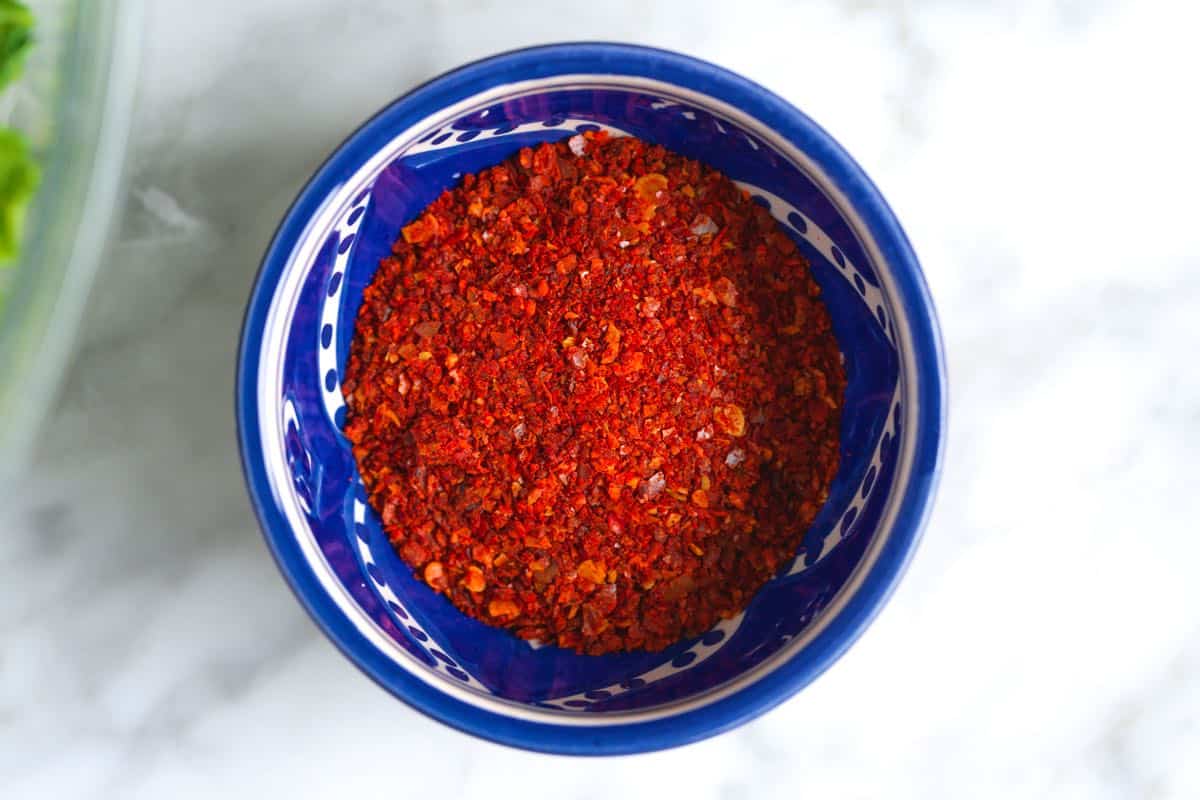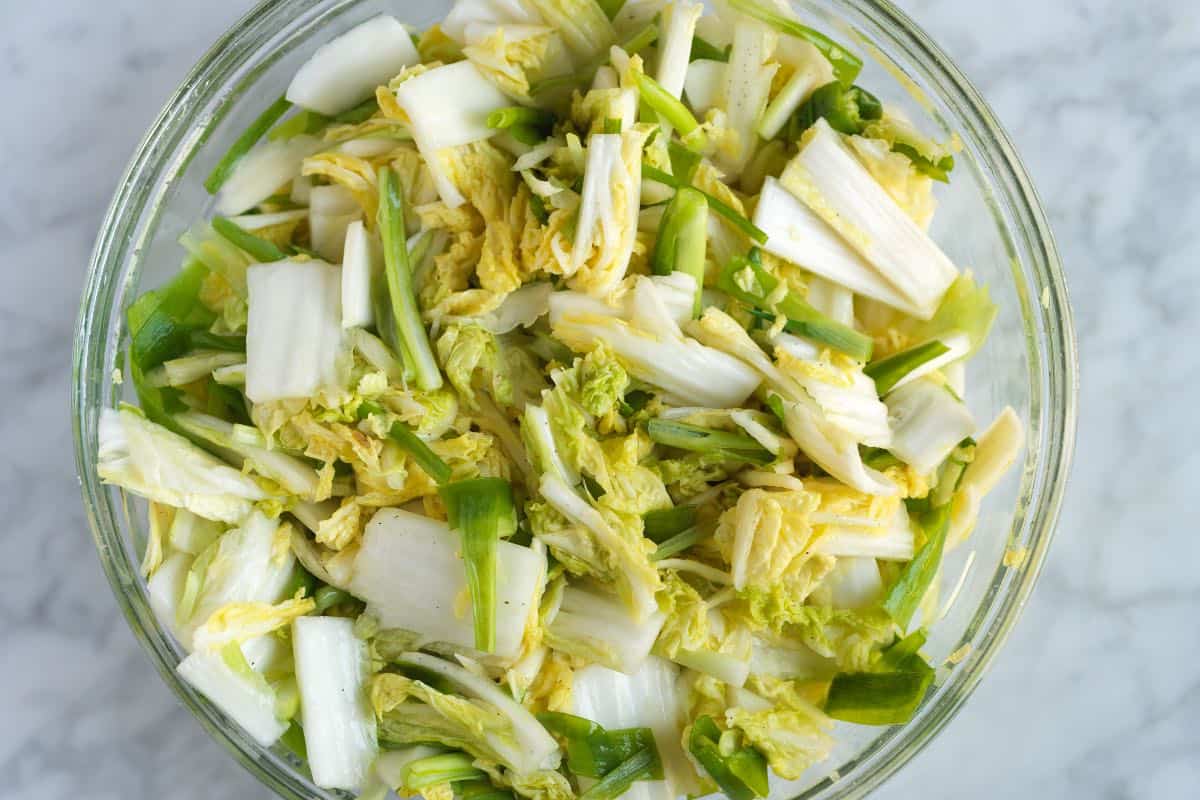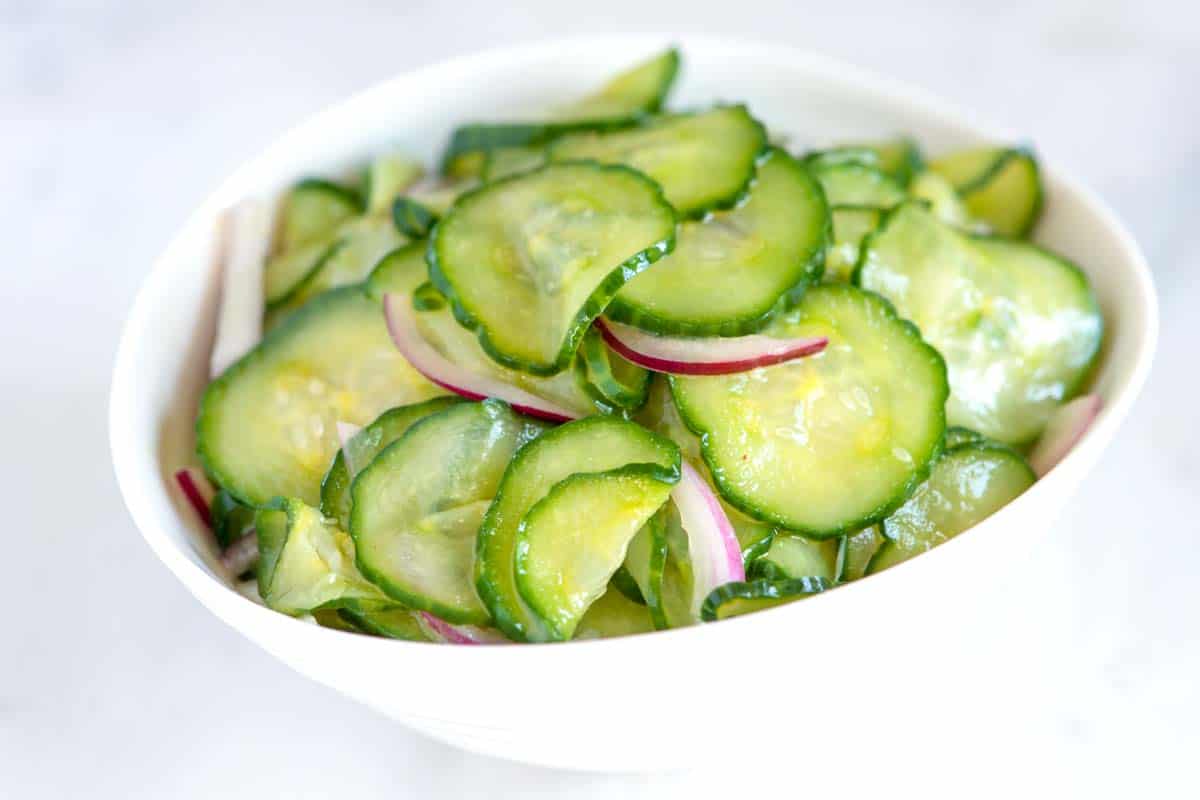We love this beginner-friendly kimchi recipe! So, if you’ve been considering making kimchi at home, now is the perfect time to give it a go! This kimchi tastes amazing. I add it to almost everything!

Kimchi, also spelled kimchee, is a beloved Korean dish made from fermented vegetables. I’m sharing our recipe for the most common variety of kimchi, which is made using napa cabbage (baechu). It is traditionally served as banchan (side dishes accompanying a meal).
Kimchi is also used in kimchi fried rice, stews, dumplings, savory pancakes, and noodles. I also add it to sandwiches, wraps, and salad bowls. Currently, my favorite way to enjoy kimchi is with scrambled eggs!
Key Ingredients
- Cabbage: I use Napa cabbage to make kimchi because it has tender, delicate leaves that soften nicely during fermentation. Its mild flavor also complements the other delicious flavors in kimchi.
- Salt: The first step in making kimchi is to cut and salt the cabbage. The salt kills harmful bacteria and helps draw out excess water from the cabbage. After letting the cabbage sit with salt, I rinse and drain it until it’s mostly dry.
- Green Onions: I love adding green onions, or scallions, to homemade kimchi. I cut them on the larger side so I can see them after fermentation. They add a fresh, oniony flavor and aroma.
- Gochugaru: This Korean red chili powder or flakes adds heat, flavor, and a vibrant red color to kimchi. I recommend using a mild gochugaru, as you can always add more to make your kimchi more vibrant without making it too spicy.
- Garlic and Ginger: I use a generous amount of fresh garlic and ginger in this recipe and like to grate them using a fine microplane grater. The grated garlic and ginger melt into the kimchi paste, adding incredible flavor.
- Fish Sauce: Kimchi often includes a seafood component like fish sauce, oysters, squid, or salted shrimp paste to add umami, a rich, savory flavor. We don’t often have most of what I listed, but I always have fish sauce, so I use that in this recipe.
- Sugar: Sugar balances the heat and spice from the gochugaru and seasons the cabbage.
- Rice Thickener: While optional, the rice thickener (a porridge of rice flour and water) helps the chili paste adhere to the cabbage. It also improves the flavor and texture of the kimchi. I’ve shared the simple steps to make it below.
How to Make Kimchi at Home
We still have much to learn about making different kimchi varieties, and we love to taste and explore other options. Our kimchi recipe below is a great entry point. It can also be adjusted to your preferred spice level, depending on how much gochugaru (red chili powder pictured below) you use. We’ve worked on this recipe with Chef Richard Hattaway. You are going to love it!

One of the best parts about kimchi is that it’s delicious fresh (unfermented), or fermented. So you can make a batch, enjoy some as a salad, and leave the rest in a jar in your fridge to ferment.
Opinions on what makes the best kimchi are varied, and that’s okay. Kimchi is a traditional dish that’s had centuries to be tweaked from family to family. This recipe is our starting point. It calls for ingredients we typically have available in our area and makes the type of kimchi we crave.
When making kimchi, we’ll need to follow two basic steps:
First, cut and salt the cabbage. This kills any bad bacteria and helps to draw out excess water from the cabbage. Then, after allowing the cabbage to sit with salt, we rinse and drain it until it’s mostly dry.

Second, massage a paste made from red chili powder (gochugaru) and other ingredients like garlic, ginger, fish sauce, and sugar into the cabbage. You can enjoy the kimchi fresh (straight away) or allow it to ferment. Fermentation will happen at room temperature or in the fridge. It’s slower in the fridge, but fermenting in the fridge is our preferred method (it is hands-off and easy).

The fermentation time for kimchi can vary depending on personal preference and the desired level of tanginess. Generally, fermentation takes 2 to 3 weeks in the fridge.
Some people allow the kimchi to ferment at room temperature for a day or more. This speeds up your fermentation, but we prefer to simply slide our jar into the fridge and let it ferment there. It’s a little slower, but after a couple of weeks, the refrigerator-fermented kimchi has all the same sour, funky notes.
In the refrigerator, kimchi can typically stay fresh for several months. However, its flavor and texture will continue to change gradually over time. Some people prefer the taste of well-aged kimchi, while others enjoy it when it’s relatively fresh. Personally, I prefer fresher styles of kimchi. Please note that our recipe below is not intended to be shelf stable (do not can or leave unrefrigerated for an extended period).

Easy Kimchi
- PREP
- TOTAL
Our kimchi recipe is beginner friendly. It’s straightforward and can be adjusted to your preferred spice level, depending on how much gochugaru (red chili powder) you use. While some recipes leave the cabbage in wedges, we chop ours into bite-size pieces. This simplifies things and saves a bit of time during the salt brine. We typically make cabbage-only kimchi and don’t add other vegetables (except garlic, ginger, and green onion), but feel free to add shredded Korean radish, daikon, or carrots.
You Will Need
Kimchi Ingredients1 napa cabbage, about 3 pounds
2 ½ tablespoons (42g) fine sea salt
12 green onions
2 tablespoons rice thickener, recipe below
5 tablespoons (45g) gochugaru, Korean red chili pepper powder
8 cloves garlic, finely grated
One 2-inch knob fresh ginger, finely grated
2 tablespoons fish sauce
4 teaspoons sugar
2 tablespoons water
Rice thickener1 tablespoon sweet rice flour
1/2 cup (118ml) cold water
Directions
1Prepare the cabbage by cutting it in half lengthwise, removing the core, and slicing it into 1 ½-inch pieces. Trim the root ends of the green onions, slice them in half lengthwise, and cut them into 2-inch pieces.
2Place the cabbage and green onions in a large bowl (or two bowls if needed). Sprinkle with salt and toss well to combine. Cover with a clean dish towel and let sit at room temperature until the cabbage wilts noticeably, about 1 to 2 hours. After 30 minutes, toss the cabbage to redistribute the salt.
3While the cabbage wilts, make the rice thickener by combining 1 tablespoon of rice flour and 1/2 cup of water in a small saucepan. Cook over medium heat, stirring constantly, until it forms a thick paste. Remove from heat and let cool.
4Make the chili paste by combining the gochugaru, garlic, ginger, fish sauce, sugar, and water. Add 2 tablespoons of the cooled rice thickener and stir until well blended. Store in the fridge until the cabbage is ready.
5Once the cabbage is wilted, rinse it well under cold water (2 to 3 times) and set it aside to drain for 20 to 30 minutes (or use a salad spinner).
Massage the chili paste into the drained cabbage (consider using gloves). Continue until all the cabbage is thoroughly coated.
6Pack the kimchi into a 1-quart jar (use a second jar or a smaller 16-ounce jar if you have extra). Press down on the kimchi until the brine covers the cabbage, leaving at least 1 inch of space between the kimchi and the lid. Place a fermentation weight on top if you have one, and seal the jar.
7Place the kimchi in the refrigerator to ferment. After a day, “burp” it by pressing down on the cabbage with a clean spoon to release trapped air bubbles
8Enjoy your kimchi at any point! It will develop funky, sour notes after a week or two. As it ferments, you might see bubbles forming and brine seeping out of the jar, so consider placing the jar inside a small bowl to catch anything.
Adam and Joanne's Tips
- Vegetarian or Vegan kimchi: Leave out the fish sauce and add 1 to 2 tablespoons of white or red miso paste to the chili powder mixture before massaging it into the cabbage.
- Salt: Use iodine-free salt. Iodine can prevent proper fermentation.
- Gochugaru: Korean red chili powder or flakes add heat, flavor, and vibrant red color to kimchi. We used Mother In Law’s Gochugaru in our photos since it is commonly available in local grocery stores. You can also find Gochugaru sold in International/Korean markets. If you have the choice between hot or mild, choose mild since you can add more and make your kimchi more vibrant without making it too spicy (tip from Maangchi).
- Spicy kimchi: Increase the gochugaru in the recipe or use gochugaru that’s labeled medium or hot to make your batch. You can taste the chili paste as you are making it to see if it is spicy.
- Nutrition facts: The nutrition facts provided below are estimates. We have used the USDA database to calculate approximate values. Note that sodium is difficult to determine with this recipe.









This is The BEST recipe. Don’t be afraid…just do it! You won’t be disappointed.
You made us smile with this review! 🙂
Thank you for sharing your Kimchi recipe. I am interested in making my own homemade kimchi recipe instead of buying from the grocery store. I read a lot of the good benefits of fermented kimchi as brobiotic and that made me started to try kimchi. And Oh boy, I got hooked. Your recipe seems easy for a begginer like me so I gonna give it a try and hope it comes out good. Thanks again!
Hi, following instructions and there is a fair amount of excess rice thickener left. Is this correct??
Yes, you are correct. You can use it to thicken gravies, soups, and sauces. We tried to make the least amount as possible, but to get the smooth consistency, we needed a bit more than what is actually used to make the kimchi.
Afternoon. Can ask you to clarify step 5 on the simple kimchi recipe as it says make sure the brine is covering the cabbage but it makes no mention of adding or saving the brine? Thank you
Hi Christopher, there isn’t a brine that you add into the jar. As you press the cabbage mixture into the jar a natural brine is created. You want to make sure that the brine covers the cabbage at the time. (a fermentation weight or pushing the kimchi down should do the trick)
Best Kimchi recipe and instructions on the internet. Thank you.
Hi. I will be trying this recipe this coming week. I absolutely love kimshi. I will let you know how it turns out. Thanks for the recipe!!
We love this recipe and it is so easy 🙂
Can tapioca flour be substituted for rice flour? Here (in Guatemala) they sell Yuca flour for tapioca flour, but I can’t find rice flour.
Hello Suzy! Although we haven’t personally tried it, you should be able to substitute tapioca flour for the sweet rice flour in the kimchi recipe above. Generally, when substituting tapioca flour for rice flour, you will want to use half the amount.